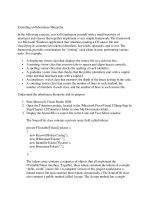Lecture 3: Extending Classes Inheritance in Java potx
Bạn đang xem bản rút gọn của tài liệu. Xem và tải ngay bản đầy đủ của tài liệu tại đây (199.69 KB, 28 trang )
1
Lecture 3:
Extending Classes
Inheritance in Java
2
Concept
•
Inheritance: you can create new classes that are
built on existing classes. Through the way of
inheritance, you can reuse the existing class’s
methods and fields, and you can also add new
methods and fields to adapt the new classes to new
situations
•
Subclass and superclass
•
Subclass and superclass have a IsA relationship: an
object of a subclass IsA(n) object of its superclass
3
Superclass
public class Person{
private String name;
public Person ( ) {
name = “no_name_yet”;
}
public Person ( String initialName ) {
this.name = initialName;
}
public String getName ( ) {
return name;
}
public void setName ( String newName ) {
name = newName;
}
sample classes
Subclass
public class Student extends Person {
private int studentNumber;
public Student ( ) {
super( );
studentNumber = 0;
}
public Student (String initialName, int
initialStudentNumber) {
super(initialName);
studentNumber = initialStudentNumber;
}
public int getStudentNumber ( ) {
return studentNumber;
}
public void setStudentNumber (int
newStudentNumber ) {
studentNumber = newStudentNumber;
}
4
Classes hierarchy
•
Every class is an extended (inherited) class, whether
or not it’s declared to be. If a class does not declared
to explicitly extend any other class, then it implicitly
extends the Object class
•
Class hierarchy of previous example
Object
Person
Student
5
Fields/Methods in Extended Classes
•
An object of an extended class contains two
sets of variables and methods
1. fields/methods which are defined locally in the
extended class
2. fields/methods which are inherited from the
superclass
What are the fields for a Student object in the previous
example
?
6
Constructors in extended classes
•
A constructor of the extended class can invoke one
of the superclass’s constructors by using the super
method.
•
If no superclass constructor is invoked explicitly,
then the superclass’s no-arg constructor
super( )
is invoked automatically as the first statement of the
extended class’s constructor.
•
Constructors are not methods and are NOT
inherited.
7
•
When an object is created, memory is allocated for all
its fields, which are initially set to be their default
values. It is then followed by a three-phase
construction:
–
invoke a superclass’s constructor
–
initialize the fields by using their initializers and initialization
blocks
–
execute the body of the constructor
•
The invoked superclass’s constructor is executed
using the same three-phase constructor. This
process is executed recursively until the Object
class is reached
Three phases of an object’s construction
8
To Illustrate the Construction Order. . .
Y objectY = new Y();
Step what happens xOri yOri whichOri
0 fields set to default values
1 Y constructor invoked
2 X constructor invoked
3 Object constructor invoked
4 X field initialization
5 X constructor executed
6 Y field initialization
7 Y constructor executed
0 0 0
0 0 0
0 0 0
0 0 0
1 0 0
1 0 1
1 2 1
1 2 2
class Y extends X {
protected int yOri = 2;
public Y() {
whichOri = yOri;
}
}
class X {
protected int xOri = 1;
protected int whichOri;
public X() {
whichOri = xOri;
}
}
9
Overloading and Overriding Methods
•
Overloading: providing more than one method with the same
name but different parameter list
–
overloading an inherited method means simply adding new method
with the same name and different signature
•
Overriding: replacing the superclass’s implementation of a
method with your own design.
–
both the parameter lists and the return types must be exactly the same
–
if an overriding method is invoked on an object of the subclass, then it’s
the subclass’s version of this method that gets implemented
–
an overriding method can have different access specifier from its
superclass’s version, but only wider accessibility is allowed
–
the overriding method’s throws clause can have fewer types listed
than the method in the superclass, or more specific types
10
Accessibility and Overriding
•
a method can be overridden only if it’s
accessible in the subclass
–
private methods in the superclass
•
cannot be overridden
•
if a subclass contains a method which has the same signature
as one in its superclass, these methods are totally unrelated
–
package methods in the superclass
•
can be overridden if the subclass is in the same package as
the superclass
–
protected, public methods
•
always will be
Not as that simple as it seems!
11
Concrete1 c1 = new Concrete1();
c1.show( );
Output?
Base.pri()
Base.pac()
Concrete1.pro()
Concrete1.pub()
Sample classes
package P1;
public class Base {
private void pri( ) { System.out.println(“Base.pri()”); }
void pac( ) { System.out.println(“Base.pac()”); }
protected void pro( ) { System.out.println(“Base.pro()”); }
public void pub( ) { System.out.println(“Base.pub()”); }
public final void show( ) {
pri(); pac(); pro(); pub(); }
}
package P2;
import P1.Base;
public class Concrete1 extends Base {
public void pri( ) { System.out.println(“Concrete1.pri()”); }
public void pac( ) { System.out.println(“Concrete1.pac()”); }
public void pro( ) { System.out.println(“Concrete1.pro()”); }
public void pub( ) { System.out.println(“Concrete1.pub()”); }
}
12
Sample classes (cont.)
package P1;
import P2.Concrete1;
public class Concrete2 extends Concrete1 {
public void pri( ) { System.out.println(“Concrete2.pri()”); }
public void pac( ) { System.out.println(“Concrete2.pac()”); }
public void pro( ) { System.out.println(“Concrete2.pro()”); }
public void pub( ) { System.out.println(“Concrete2.pub()”); }
}
Concrete2 c2 = new Concrete2();
c2.show( );
Output?
Base.pri()
Concrete2.pac()
Concrete2.pro()
Concrete2.pub()
13
Sample classes (cont.)
package P3;
import P1.Concrete2;
public class Concrete3 extends Concrete2 {
public void pri( ) { System.out.println(“Concrete3.pri()”); }
public void pac( ) { System.out.println(“Concrete3.pac()”); }
public void pro( ) { System.out.println(“Concrete3.pro()”); }
public void pub( ) { System.out.println(“Concrete3.pub()”); }
}
Concrete3 c3 = new Concrete3();
c3.show( );
Output?
Base.pri()
Concrete3.pac()
Concrete3.pro()
Concrete3.pub()
14
Hiding fields
•
Fields cannot be overridden, they can only
be hidden
•
If a field is declared in the subclass and it
has the same name as one in the superclass,
then the field belongs to the superclass
cannot be accessed directly by its name any
more
15
Polymorphism
•
An object of a given class can have multiple forms: either
as its declared class type, or as any subclass of it
•
an object of an extended class can be used wherever the
original class is used
•
Question: given the fact that an object’s actual class type
may be different from its declared type, then when a
method accesses an object’s member which gets
redefined in a subclass, then which member the method
refers to (subclass’s or superclass’s)?
–
when you invoke a method through an object reference, the actual
class of the object decides which implementation is used
–
when you access a field, the declared type of the reference decides
which implementation is used
16
Example Classes
class SuperShow {
public String str = “SuperStr”;
public void show( ) {
System.out.println(“Super.show:” + str);
}
}
class ExtendShow extends SuperShow {
public String str = “ExtendedStr”;
public void show( ) {
System.out.println(“Extend.show:” + str);
}
public static void main (String[] args) {
ExtendShow ext = new ExtendShow( );
SuperShow sup = ext;
sup.show( ); //1
ext.show( ); //2 methods invoked through object reference
System.out.println(“sup.str = “ + sup.str); //3
System.out.println(“ext.str = “ + ext.str); //4 field access
}
}
Output?
Extend.show: ExtendStr
Extend.show: ExtendStr
sup.str = SuperStr
ext.str = ExtendStr
17
Type compatibility
•
Java is a strongly typed language.
•
Compatibility
–
when you assign the value of an expression to a variable, the
type of the expression must be compatible with the declared
type of the variable: it must be the same type as, or a subtype
of, the declared type
–
null object reference is compatible with all reference types.
18
Type conversion (1)
•
The types higher up the type hierarchy are said to be
wider, or less specific than the types lower down the
hierarchy. Similarly, lower types are said to be
narrower, or more specific.
•
Widening conversion: assign a subtype to a
supertype
–
can be checked at compile time. No action needed
•
Narrowing conversion: convert a reference of a
supertype into a reference of a subtype
–
must be explicitly converted by using the cast operator
19
Type conversion (1)
•
The types higher up the type hierarchy are
said to be wider, or less specific than the
types lower down the hierarchy. Similarly,
lower types are said to be narrower, or more
specific.
•
Two kinds of type conversions:
1. Widening conversion: assign a subtype to a supertype
2. Narrowing conversion: convert a reference of a
supertype into a reference of a subtype
20
Type conversion (2)
•
Explicit type casting: a type name within
parentheses, before an expression
–
for widening conversion: not necessary and it’s a safe cast
e.g. String str = “test”;
Object obj1 = (Object)str;
Object obj2 = str;
–
for narrowing cast: must be provided and it’s an unsafe cast
e.g. String str1 = “test”;
Object obj = str1;
String str2 = (String)obj;
Double num = (Double)obj;
If the compiler can tell that a narrowing cast is incorrect, then a
compile time error will occur
If the compiler cannot tell, then the run time system will check
it. If the cast is incorrect, then a ClassCastException will be
thrown
21
E.g. Student is subclass of Person
public class typeTest {
static Person[] p = new Person[10];
static
{
for (int i = 0; i < 10; i++) {
if(i<5)
p[i] = new Student();
else
p[i] = new Person();
}
}
public static void main (String args[])
{
Person o1 = (Person)p[0];
Person o2 = p[0];
Student o3 = p[0];
Student o4 = (Student)p[0];
Student o5 = p[9];
Student o6 = (Student)p[9];
int x =
p[0].getStudentNumber();
}
}
%> javac typeTest.java
typeTest.java:17 incompatible types
found : Person
required : Student
Student o3 = p[0];
^
typeTest.java:19 incompatible types
found : Person
required : Student
Student o5 = p[9];
^
typeTest.java:21: cannot resolve symbol
symbol : method getStudentNumber ()
location: class Person
int x = p[0].getStudentNumber();
^
3 errors
After commenting out these three ill lines:
%> java typeTest
Exception in thread “main”
java.lang.ClassCastException: Person
at typeTest.main(typeTest.java:20)
22
Type conversion (3)
•
Type testing: you can test an object’s actual class by
using the instanceof operactor
e.g.if ( obj instanceof String)
{
String str2 = (String)obj;
}
23
Abstract classes and methods (1)
•
abstract classes: some methods are only declared,
but no concrete implementations are provided. They
need to be implemented by the extending classes.
abstract class Person {
protected String name;
. . .
public abstract String getDescription();
. . .
}
Class Student extends Person {
private String major;
. . .
pulic String getDescription() {
return “a student major in “ + major;
}
. . .
}
Class Employee extends Person {
private float salary;
. . .
pulic String getDescription() {
return “an employee with a salary of $ “ + salary;
}
. . .
}
Person
Employee Student
24
Abstract classes and methods (2)
•
each method which has no implementation in the abstract
class must be declared abstract
•
any class with any abstract methods must be declared
abstract
•
when you extend an abstract class, two situations
1. leave some or all of the abstract methods be still undefined. Then the
subclass must be declared as abstract as well
2. define concrete implementation of all the inherited abstract methods.
Then the subclass is no longer abstract
•
an object of an abstract class can NOT be created
•
note that declaring object variables of an abstract class is still
allowed, but such a variable can only refer to an object of a
nonabstract subclass
E.g. Person p = new Student( );
25
protected members
•
To allow subclass methods to access a superclass
field, define it protected. But be cautious!
•
Making methods protected makes more sense, if
the subclasses can be trusted to use the method
correctly, but other classes cannot.









